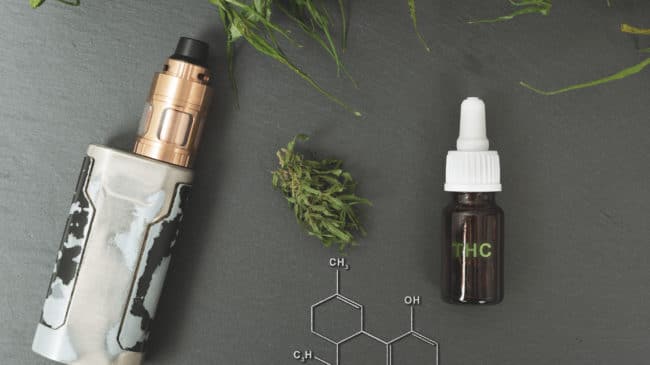As the story about vaping-related illnesses unfolded, it became increasingly clear that black market marijuana vaping products containing a chemical called vitamin E acetate were the culprits.
In its most recent update, the Centers for Disease Control and Prevention (CDC) reports:
As of February 18, 2020, a total of 2,807 hospitalized EVALI cases or deaths have been reported to CDC from all 50 states, the District of Columbia, and two U.S. territories (Puerto Rico and U.S. Virgin Islands).
Sixty-eight deaths have been confirmed in 29 states and the District of Columbia (as of February 18, 2020).
National and state data from patient reports and product sample testing show tetrahydrocannabinol (THC)-containing e-cigarette, or vaping, products, particularly from informal sources like friends, family, or in-person or online dealers, are linked to most EVALI cases and play a major role in the outbreak.
Vitamin E acetate is strongly linked to the EVALI outbreak. Vitamin E acetate has been found in product samples tested by FDA and state laboratories and in patient lung fluid samples tested by CDC from geographically diverse states. Vitamin E acetate has not been found in the lung fluid of people that do not have EVALI.
Even after CDC accurately shifted the blame to THC products bought on the black market, the deaths and illnesses prompted a series of calls for a complete ban on all vaping products, while others suggested that marijuana legalization in states was to blame and should be reversed.
The panic, and these calls for prohibition, were misguided. The implicit argument behind the calls for bans, in this case, is that the producers of legal vaping and marijuana products cannot be trusted and that consumers cannot differentiate between legal and counterfeit products, so the choices should be taken away from the adults using these products.
However, a recent analysis by Reason Foundation’s Jacob James Rich and Cato Institute’s Jeffrey Miron found that the states permitting recreational marijuana sales actually have lower rates of vaping-related illness than states that have not legalized cannabis. This is because, in part, dangerous adulterations of THC vaping products are found almost exclusively on the black market, where illicit suppliers aren’t subject to testing, civil court damages and other mechanisms that incentivize safer products.
But now several cannabis companies are working together to create a technology-based solution that would require no government intervention, just some personal initiative. It works by placing a QR code, similar to a bar-code seen on nearly all retail packaging, onto the packaging of a vape product. Customers can scan the code with their smartphones to verify the authenticity of the product. The QR code only scans and activates if the product was legally and compliantly made, as each code is unique and attached to the product by the supplier. If the box has no QR code or it doesn’t show up after being scanned, consumers should be wary.
This shows how companies and consumers can use technology to help customers verify whether they are buying a legal or illegal product without the government having to be involved. The system would be completely paid for by private cannabis companies that have a financial incentive to build their credibility as they sell legal marijuana products to consumers.
Illegal products are to blame for vaping-related illnesses and deaths. As regulators dig deeper and look for ways to prevent future problems, they may want to look at how the legal marijuana market is taxed and regulated.
One of the major benefits of marijuana legalization is that products are subject to safety tests. Unfortunately, high state and local marijuana taxes, combined with excessive regulations on marijuana businesses and licenses, are playing a role in keeping legal cannabis prices high enough that many black market products remain significantly less expensive, and thus more attractive to consumers.
Depending on the city and state, legal marijuana products can be 20-to-50 percent more expensive than illegal products due mostly to taxation and regulation. We can call this a “legal premium,” for which basic economics predicts—correctly in this case given the volume of illegal marijuana products—that some percentage of customers will forgo paying the premium for legal products and instead choose the cheaper black market alternatives. In these cases, marijuana legalization by states and cannabis businesses growing and selling products are not to blame. The excessive taxes and regulations placed on the industry, which have allowed the market for cheaper alternative products to continue to thrive, are to blame for people continuing to seek out those products.
Going forward, policymakers in states that have legalized marijuana should be looking to provide stable regulations and tax rates to the industry so that entrepreneurs and investors are encouraged to take financial risks in the market to develop products like the QR code for quality control. The incentive to invest in cannabis businesses is much less than it should be if investors fear the entire market could potentially be wiped out or hindered by states or the federal government, which is where we are now.
In conclusion, while vaping illnesses and deaths caused by illegal products are certainly concerning, more government regulation of marijuana or vaping is not going to solve the problem. Consumers deserve to know where their products came from, but this does not necessitate a government mandate. Entrepreneurs have shown that not every potentially harmful situation necessitates government regulations and that market solutions, like the QR code for quality control, can be quickly and effectively devised. Rather than seeking all-out bans or new restrictions, policymakers could choose a more effective path: reducing marijuana taxes and regulations that allow the legal market to develop and innovate in ways that make it more competitive with the black market.
